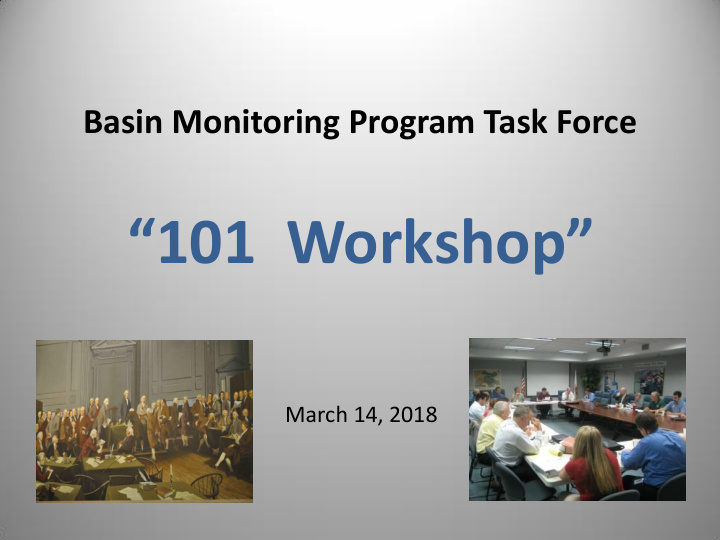



Basin Monitoring Program Task Force “101 Workshop” March 14, 2018
Basin Monitoring Program Task Force City of Riverside Eastern Municipal Water District City of Corona Inland Empire Utilities Agency City of Redlands Orange County Water District City or Rialto Irvine Ranch Water District City of Banning Beaumont Cherry Valley Water District Lee Lake Water District San Bernardino Valley MWD Chino Basin Watermaster San Gorgonio Pass Water Agency Yucaipa Valley Water District Jurupa Community Services District Elsinore Valley MWD W. Riverside Co. Reg. Wastewater Auth. City of Beaumonth Colton/San Bernardino RTTTWR (RIX)
Basin Monitoring Program Task Force 1) What is it and why was it formed? 2) What does it do and why is it important? 3) What are the future goals and priorities?
Basin Monitoring Program Task Force Implements the Water Quality Monitoring Program (R8-2005-0063) 1) Annual Report of SAR Water Quality 2) Ambient Groundwater Quality Update 3) Waste Load Allocation Model (WLAM)
Resolution 68-16: The Antidegradation Policy Predates: 1) 1969 Judgment 2) Porter-Cologne Act 3) First Basin Plans 4) Clean Water Act
The Rancho Caballero Case (1972) • Receiving Water Quality = 900 mg/L • Effluent Quality = 755 mg/L • Basin Plan Objective = 700 mg/L “Arlington - Riverside Groundwater Basin has no capacity to assimilate…” SWRCB WQO No. 73-4
The Recycled Water Issue (1991-94) • Basin Plan Objectives = 400 - 500 mg/L • Effluent Quality = 550 – 650 mg/L • Receiving Water Quality = 600+ mg/L
N Nitrate-N (mg/L) Current - Historical Concentrations 0 1 2 3 4 5 Miles 1.3 2.0 1.8 0.7 San Jacinto Fault San Andreas Fault G G G -1.8 G 3.4 G G 0.2 4.8 G 0.5 G G 4.5 ù 1.0 ù ù ù -2.6 -1.8 7.2 15.8 1.5 0.8 6.2 Not enough da ta G G Not enough da ta -0.5 0.9 2.3 1.2 -0.3 0.5 0.5 1.1 -0.9 2.4 Not enough da ta 1.1 ù ù ù ù ù ù 1.5 2.6 Lak e Elsinore 1.6
Basin Monitoring Program Task Force Implements the Water Quality Monitoring Program (R8-2005-0063) Annual Report of SAR Water Quality Ambient Groundwater Quality Update Waste Load Allocation Model (WLAM)
The Waste Load Allocation Model
Key Factors Considered in the WLAM: 1) Precipitation 6) Percolation 2) Land Use 7) Water Transfers 3) Runoff 8) Discharges 4) Evaporation 9) Rising Groundwater 5) Aeration 10) Nitrogen Loss Can the discharge(s) be permitted and, if so, what effluent limits should apply?
Major Accomplishments: 1) Eleven Annual Reports of SAR Water Quality 2) Four Ambient Groundwater Updates 3) Two WLAM Updates 4) Dozens of NPDES Permit Renewals 5) Four Basin Plan Amendments 6) Prevented New 303(d) Listings 7) ZERO Litigation
Near Term Priorities 1) Complete WLAM Update (2018) 2) Develop a Draft Drought & Conservation Policy 3) Next AWQU = 2019 4) Index Task Force’s On -Line Resource Library 5) Consider Expanding Task Force Membership
Long-Term Goals 1) Clarify Water Quality Assessment Procedures 2) Validate/Update TDS Objectives @ Prado Dam 3) Investigate Other Sources of TDS @ Prado Dam 4) Recycled Water Policy Updates 2030 1960 1970 1980 1990 2000 2010 2020
New Challenges 1) EPA’s New Conductivity Guidance 2) State Board's New Biocriteria Policy 3) 303(d) Assessment in 2020-22 4) Minimum Flow Requirements? 5) Mass-based Effluent Limits?
Those who cannot remember the past… …are condemned to repeat it.
Basin Monitoring Program Task Force “101 Workshop” March 14, 2018
Recommend
More recommend